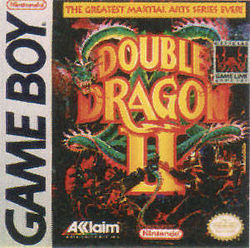- Double Dragon II (Game Boy)
-
Double Dragon II
Nekketsu Kōha Kunio-kun: Bangai Rantō Hen
Double Dragon II cover art, modeled after the North American and European front cover of the NES version of Double Dragon 3: The Rosetta Stone.Developer(s) Technos Japan Publisher(s) Designer(s) Hiroyuki Kikuchi
Masahiro YoshiharaComposer(s) Kazuo Sawa Platform(s) Game Boy Release date(s) Genre(s) Beat 'em up action Media/distribution Cartridge Double Dragon II is a 1991 beat-em-up released for the Game Boy developed by Technos Japan Corp. and published by Acclaim in North America and Europe.
Although it is the second Double Dragon game released for the Game Boy, it is unrelated to the arcade and NES game Double Dragon II: The Revenge. The game is a localization of the 1990 Japanese Game Boy game Nekketsu Kōha Kunio-kun: Bangai Rantō Hen (熱血硬派くにおくん 番外乱闘編, "Hot Blooded Tough Guy Kunio: The Further Brawls), which was part of Technos Japan's Kunio series. The graphics, music, and storyline were changed for the international versions.[1]
Contents
Gameplay
The player take control of martial artist Billy Lee, who is being hunted down by an organization called the "Scorpions" for murdering one of its members. The objective of the game is to fight off the members of the Scorpions and confront the true culprit, a rival martial artist named Anderson. Unlike the Game Boy version of the first game, a second player can now join anytime via the use of a Game Link Cable, taking control of Billy's brother, Jimmy.
The play mechanics are simplistic compared to previous Double Dragon games. Like in the Game Boy version of the first game, the player has a punch button and a kick button. However, instead of jumping, pressing both buttons will cause the character to kneel. While kneeling, pressing either button will cause the player to perform a jumping uppercut. Instead of the hair grab from previous games, the player will do a collar grab (similar to Renegade), in which the player can repeatedly knee kick the opponent or toss them. The player also leap over fallen opponents as well. Despite the presence of armed enemies, the player cannot disarm them and pick up their weapons like in other Double Dragon games.
The game is composed of three stages, with four levels for the first two stages and two for the final stage (a total of ten levels). The third and final stage is only available when the game is played on the Normal or Hard difficulty setting.
Regional differences
The Japanese version, Nekketsu Kōha Kunio-kun: Bangai Rantō Hen, was released on December 7, 1990. The Japanese version features completely different graphics (similar to those featured in Downtown Nekketsu Monogatari, the Japanese version of River City Ransom), music, storyline, and characters (with Kunio and Riki being replaced by Billy and Jimmy in the international versions). However, the play mechanics, level designs, and overall structure of the game are otherwise identical.
References
- ^ "Double Dragon II: The Revenge." Moby Games. Retrieved on April 2, 2009.
External links
- Double Dragon II: The Revenge (Game Boy) - IGN
- Double Dragon II (Game Boy) - Gamefaqs
- Double Dragon II - Gamespot
Related games Adaptions Kunio-kun video games Fighting Sports Super Dodge Ball · Super Dodge Ball (NES) · Super Dodge Ball (Neo Geo) · Super Dodgeball Brawlers · Nintendo World Cup · Crash 'n the Boys: Street Challenge · Nekketsu! Street Basket: Ganbare Dunk Heroes · River City Soccer HooligansRelated games This beat 'em up video game article is a stub. You can help Wikipedia by expanding it.
